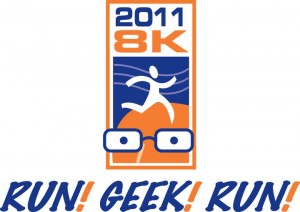On September 15 at 8am, I stood on the starting line of an 8k road race in historic West Potomac Park. To my right, planes took off from Reagan National Airport and flew over the Potomac River. To my left, tourists walked to the Franklin Delano Roosevelt Memorial.
16 minutes later, I was suffering.
The race was the Run! Geek! Run! 8k and it was a tune-up race before my peak race next month – a 10 miler in Maryland. As a tune-up race, it went well. But taken out of context it was a disaster.
See for yourself. Here are my splits:
Mile 1: 5:10
Mile 2: 5:16 (10:27)
Mile 3: 5:15 (15:42)
Mile 4: 5:36 (21:18)
Mile 5: 5:40 (26:58)
Look at that positive split! That’s how you shouldn’t run a race. You can see the full results here.
I started strong, running aggressively at PR pace for the first three miles. A strong headwind during the final two miles prompted a dramatic slowing, accompanied by lower leg soreness from a workout earlier in the week.
My breathing was controlled but my legs were taking a beating. Before the race, I wasn’t even sure that I would finish – my right arch was unreasonably sore and I thought racing flats (my Zoom Streak XC’s) would only make it worse.
The pain resolved itself temporarily thanks to pre-race adrenaline but resurfaced about three miles into the race. Even though my pace slowed considerably, I don’t consider this race a failure. It had a specific purpose in my training and I accomplished my goal: to suffer.
See, I recently finished rereading Matt Fitzgerald’s book Brain Training and one of the core components of tune-up races is to practice the art of suffering. It’s highly instructive to the brain-body connection and teaches your brain that running related pain and fatigue won’t cause death or bodily harm. So the next time you race, your brain allows you to push your body a little faster.
Fitzgerald has a lot of research to back it up and I’m in agreement with his brain-centered model of training. If you have a chance to read the book I highly recommend it.
What to Expect in a Tune-up Race
Tune-up races are, at their simplest, practice races. One of their primary benefits is to provide you with an indicator of your current fitness level so you can see if your training needs to be adjusted or if you’re on track to reach your Peak Race goal.
However, it’s important to remember that tune-up races aren’t goal races. Even though you might be running them at 100% effort, you can’t expect yourself to have a breakthrough performance (although, it’s possible).
Your performance will be slower (maybe a lot slower!) than your best. Here’s why:
- There’s no taper before a tune-up race
- You haven’t done specific workouts geared toward the shorter distance
- You’ll probably feel more tired than usual; you’re “training through” the tune-up
- Since it’s not a Peak Race, you don’t have the race mindset to “see God” (i.e., run as hard as you can!)
A sub-optimal performance at a tune-up race can seem discouraging at first, but take it with a grain of salt for the above reasons.
My 26:58 8k from last weekend is a full 39 seconds slower than my PR from 2005 (I was 16th at the East Coast Athletic Conference Championships – missing the All-ECAC team by less than one second!) – but it’s actually very encouraging.
First, I went into the race really sore from a tough mid-week workout. If we look at my favorite graph – the Stress Adaptation Cycle – below, I was definitely under the recovered midline:
Without rest and recovery, there are no great performances. <– Like that? Click here to tweet it!
As the title of this post suggests, practice makes perfect. It’s true for racing as well – the more you do it, the more you’ll become accustomed to the unpleasant feeling of pushing yourself. In Brain Training, Fitzgerald discusses the phenomenon of habituation and defines it as:
“A form of learning in which repeated presentation of a stimulus leads to a weakening of a response – you jump the first time you hear a loud noise, but if it is repeated over and over you jump less.”
Like a loud noise that startles you at first, a race can certainly scare you! But when it is repeated often, habituation occurs and excessive pre-race anxiety, “suffering,” and fear are less common.
Fitzgerald continues:
“It is possible to habituate oneself to fatigue-related discomfort in running, and thus to fear it less, experience at least the suffering component less acutely, and react to feelings of fatigue less strongly (by not slowing down as much, as soon, or at all). As with every other form of habituation, the secret to desensitizing your brain to fatigue-related pain and suffering is to experience it and survive it.”
This is why my goal in the Run! Geek! Run! 8k was to prioritize suffering. I shouldn’t have run 5:10 for the opening mile on tired legs and kept up a similar, grueling pace (faster than my PR pace) for the next two miles. But after nearly four months without racing, I needed a good reminder that races hurt. And that’s not a bad thing.
The silver lining of this race debacle is that my 3-mile split of 15:42 is one of the fastest 3-mile splits I’ve ever run…period. My 26:26 8k in 2011 was two seconds faster and I was faster for only a handful of 5k races on the track when in peak shape.
The lesson: I’m in great shape right now to likely run PR’s at the 5k, 8k, and 10k distances. I just need to rest!
Running a Tune-up Race as a Workout
Tune-up races don’t always have to be at 100% effort – they can also be run as workouts. I didn’t do this at last weekend’s 8k, but I’ve done it in the past. The atmosphere can help you run a great workout within the confines of normal race day conditions: corrals, aid stations, travel logistics, crowds, pre-race anxiety, warm-up timing, fueling, etc.
Two years ago to prepare for the Cherry Blossom 10 Miler I ran a 5k in 16:52 with a 14 mile warm-up. Running that fast on tired legs is a tough workout and the race conditions helped me achieve what I normally couldn’t while running alone. The pace of that 5k was 5:26 per mile – just about my goal for the 10 miler.
One of the most popular and effective ways to run a race as a workout is to practice your Peak Race pace (like I did in that 5k). It’s simple: you run a shorter race but at your goal Peak Race pace. This allows you a highly race-specific workout with nearly the same race conditions that you’ll encounter at your Peak Race.
Since the workout is shorter than your Peak Race you won’t have to put forth a 100% effort and manage the muscle damage that Peak Races typically inflict. That leads us to a good question…
What are the best race distances for tune-ups?
There’s much variability here and you could conceivably run almost any distance depending on how you run the tune-up.
But here’s a good rule of thumb:

This is best used when you’re racing your tune-up. If you’re doing it as a workout (i.e., not at full effort) then you can run a longer distance. For example, if your Peak Race is a half marathon then a 10 mile race might be too demanding to do at 100% effort. A better option is to run the first 5 miles at marathon pace and the final 5 miles at half marathon pace.
If your Peak Race is a 5k then you could do a 10k as a tune-up workout: the first 5k at half marathon pace and the final 5k at 10k pace. This turns the race into a type of tempo run that provides a great endurance stimulus to your 5k training. Another alternative is to run a fartlek during the final 2-3 miles. The options are endless!
My inner (or not so inner) workout geek is coming out to play…
Marathon Tune-ups – Beware!
You’ve likely heard that the half marathon provides the ideal tune-up race before your marathon. And it’s true – the half gives you an accurate estimate of your fitness level and can help predict your marathon finish time.
But they present a major drawback: because of its length, the half requires you to take more recovery time than a shorter race when you should be prioritizing training. Your legs will be plenty sore after racing 13.1 miles and reducing precious marathon training after the race is necessary.
Marathoners should race a half marathon before a marathon only if they’re already in very good shape, injury-free, and know they can recover enough in 2-3 days to resume normal training. If you tend to recover more slowly or know your body can’t handle the demands of a half, choose a shorter tune-up race like 10k or 10 miles.
In an ideal world, you’d schedule your half 4-6 weeks before your marathon (and only race one at 100% effort!). Don’t underestimate 13.1 miles – they’re not forgiving.
Taking the Next Step

For more detailed advice on scheduling marathon tune-up races – like recovery tips and what to do with your long run the weekend of a tune-up – join over 300 runners at Run Your BQ when we open soon. Run Your BQ is a private coaching and running community that will help you run a faster marathon.
Inside, there’s a forum where you can talk with other marathoners (and me!), 20+ video demonstrations, and over 45 lessons on how to improve your marathon. We also have live, video Coaches’ Chats where we answer your specific questions.
My partner on Run Your BQ, Matt Frazier of No Meat Athlete, and I are announcing a big change to the program next week that’s taking our growing community to the next level.
If you want to get exclusive marathon advice – plus advanced notice when we open – sign up here. Are you ready?!
